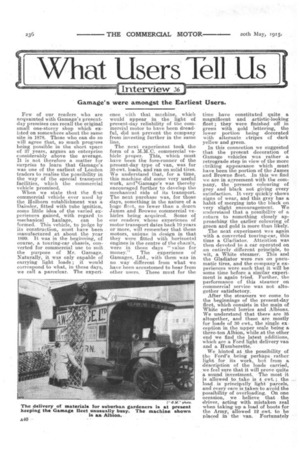What Users Tell Us Interview 36
Page 12

Page 13

If you've noticed an error in this article please click here to report it so we can fix it.
Garnage's were amongst the Earliest Users.
Few of our readers who are acquainted with Gamage's presentday premises can recall the original small one-storey shop which existed on somewhere about the same site in 1878. Those who can do so will agree that, so much progress being possible in the short space of 37 years, argues an enterprise considerably above the average. It is not therefore a matter for surprise to learn that Gamage's was one of the earliest of London traders to realize the possibility in the way of the special transport facilities, which the commercial vehicle promised.
When we state that the first commercial vehicleever used by the Holborn establishment was a Daimler, fitted with tube ignition, some little idea of the varied experiences gained, with regard to mechanical haulage, can be formed. This vehicle, to judge by its construction,. must have been manufactured at about the year 1899. It was in the beginning, of course, a touring-car chassis, converted for commercial use to snit the purpose of Mr. Gamage. Naturally, it was only capable of carrying light loath; it would correspond to what, in these days, we call a parcelcar. The experi
ence with that machine, which would appear in the light of present-day reliability of the commercial motor to have been dreadful, did not prevent the company from investing further in the same The next experiment took the form of a M.M.C. commercial vehicle proper. This, which must have been the fore-runner of the present-day type of van, was for 30-cwt. loads, and ran on solid tires. We understand that, for a time, this machine did some very useful work, aneGamage's was thereby encouraged further to develop the mechanical side of its transport. The next purchase was, for those days, something in the nature of a huge 11.2et, no fewer than a dozen James and Browne commercial vehicles being acquired. Some of our readers, whose experience of motor transport dates back 10 years or more, will remember that these motors, unique in design in that they were fitted with horizontal engines in the centre of the chassis, were in those days " value for money." The experience of Gamages, Ltd., with them was in no way different from what we have been accustomed to hear from other users. These must for the time have constituted quite a magnificent and artistic-looking fleet ; they were finished off in green with gold lettering, the lower portion being decorated with alternate stripes of dark yellow and green.
In this connection we suggested that the present decoration of Gamage vehicles was rather a retrograde step in view of the more striking appearance which must have been the portion of the James and Browne fleet. In this we find we are in agreement with the company, the present colouring of grey and black not giving every satisfaction. It very quickly shows signs of wear, and this grey has a habit of merging into the black on very slight encouragement. We understand that a possibility of a return to something closely approaching the earlier colouring of green and gold is more than likely.
The next experiment wes again with a converted touring-car, this time a Gladiator. Attention was then devoted to a car operated on an entirely different principle, to wit, a White steamer. This and the Gladiator were run on pneumatic tires, and the companylfi experiences were such that it will be some time before a similar experiment is again tried. Further, the performance of this steamer on commercial service was not altogether satisfactory.
After the steamers we come to the beginnings of the present-day fleet, which consists in the main of White petrol lorries and Albions. We understand that there are 35 altogether, and these are mostly for loads of 30 cwt., the single ex. eeption in the upper scale being a three-ton Albion, while at the other end we find the latest additions, which are a Ford light delivery van and a Humberette.
We hinted at the possibility of the Ford's being perhaps rather light for its work, but from a description of the loads carried, we feel sum that it will prove quite a sound investment. The most it is allowed to take is 4 cwt. ; the load is principally light parcels, and every care is taken to avoid the possibility of overloading. On one occasion, we believe that the driver, acting with mistaken zeal when taking up a load of boots for the Army, allowed 12 cwt. to be placed in the van. Fortunately
this came to the ears of others in authority and they were able to arrange for the load to be transferred to another of the vehicles which happened to turn up in time.
We gather that the present fleet is giving every satisfaction. The point on. which Carnage's lay great stress in the working of commercial vehieles is that the maximum speed of working should not be high. In this respect the Albions show to advantage, as they arc fitted with 'governors, limiting the maximum speed to something in the region of 15 m.p.h. Experiences of many users have gone far to show that excessive speed is responsible for a large proportion of the maintenance charges. It is found that at high speed the goods in the van are liable to be thrown about and damaged in transit.
A. W. Carnage, Ltd., does not utilize horses, only in exceptional cases, as, for instance, when urgent deliveries over short distances are necessary. On such occasions the aid of the local jobmaster is called in, and the necessary horsed conveyances are borrowed.






















